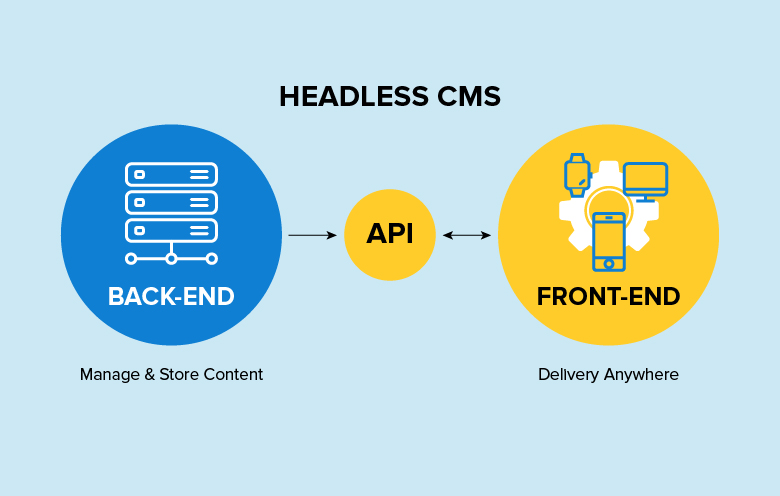
Mar 11, 2025
Every day the digital world around us evolves, entailing growing organizations to remain agile and efficient. Organizations struggle to manage content across many platforms as they publish photos, videos, and text to provide omnichannel content experiences. As a result of this challenge, the number of headless content management systems (CMSs) has increased.
Here’s why: a headless CMS separates the back end of a CMS from its front-end presentation. In brief, a headless CMS provides a centralized location for authors to create, manage and distribute content to all consumer channels. This blog post will help you gain insights into the headless CMS implementation becoming popular as the way of the future.
Why headless CMS is better than traditional CMS
Traditional CMSs are phenomenal systems that allow you to manage your site from a single source. While most are single-site solutions, many use plugins to offer multi-site or API access to share digital resources with third-party apps. However, these plugins each have their own set of challenges and benefits.
Here’s how a headless CMS development is better when compared to a traditional CMS. It does not connect directly with a front-end. The headless CMS is designed to solely focus on the content. After being created and edited, content is published using an API and that’s about it.
The front-end remains unaffected by the headless CMS. This allows content managers the freedom to disseminate their content in a variety of ways, regardless of how it is displayed. To better understand this, let’s imagine a scenario: Consider the headless CMS to be an author working on a book. The content is created by the author using a headless CMS, while the publisher uses a website format to provide the content to the public in the form of a paperback or possibly an e-book. In brief, the methods of content consumption may be distinct, but the content remains consistent.
| Traditional CMS | Headless CMS | |
|---|---|---|
| Unable to use the same content in seamless manner | Tailors user experiences and improves web accessibility | |
| Creates limited display and user experience | Centralizes content management | |
| Making changes can mean modifying the entire system | Supports omnichannel architecture | |
| Time-consuming enhancements and upgrades | Unlimited hosting options | |
| Lack of scalability | Shorter deployment time |
Why businesses should opt for headless CMS
1. Tailors user experiences and improves web accessibility
The standards of user experiences keep raising every year and as they rise, so do the user’s expectations. As a marketer, you can use the headless CMS to provide tailored experiences on any device. By doing so, you can ensure that your website features deliver the same omnichannel experience. This leads to your users advocating your brand.
Additionally, headless CMS is the key when it comes to accessibility. A headless CMS can help developers struggling with web accessibility to remain compliant and provide a consistent level of experience to all users.
2. Centralizes content management
Instead of managing content across various platforms and countless different solutions to get it published, you can manage it all in one place with a headless CMS. Headless CMSs help you to achieve this by distributing your content in a universal format and centralizing content management. You can manage your content from a single, end-to-end location.
3. Supports omnichannel architecture
Although marketers must generate iconic content that shines across all touchpoints, omnichannel might be a difficult task for them. Instead of managing each channel separately, you can create a unified experience that is consistent and relevant across all touchpoints with a headless CMS. These challenges are exacerbated by the growing number of digital touchpoints and languages that marketers must update in such a short period of time. These significant hurdles are addressed using a headless CMS.
4. Unlimited hosting options
Because the backend and frontend are separated, your website will not experience any downtime or performance reduction if the back-end CMS platform encounters any performance issues or requires maintenance. With a headless CMS and deployment environment, your hosting options are virtually limitless.
5. Shorter deployment time
Assume you want to update your website content. With a traditional CMS, you will have to start over and rebuild everything. A headless CMS, on the other hand, allows you to refresh a section or a portion of the entire application without having to rebuild it entirely.
Any front-end framework can be used to build your stack with any leading edge headless CMS. This enables your existing developers to continue working with whatever technology they are already familiar with. A cloud-first headless CMS is generally much easier and straightforward to use, resulting in shorter implementation times. Furthermore, because the CMS is delivered as a cloud service, you save a significant amount of time on deployment and configuration.
6. Increases time-to-market
In recent times, content is created and published at a rapid pace across a wide range of channels and platforms. A headless CMS enables you to update content once and publish it everywhere. This reduces brand inconsistencies across channels and, as a result, increases time to market by eliminating the need to conduct repeated processes or duplicate work to complete multiple touchpoints.
Headless CMS is the way to go!
Headless CMS is extremely handy for marketing heads. You can develop and maintain content on your own instead of going through the tiresome process of displaying information accurately across all media.
A headless CMS is similar to a content repository that can offer content via APIs to any front-end or device, extending your capabilities in a variety of digital formats like a web page or a native mobile app. In a nutshell, a headless CMS implementation makes it easier to deliver an omnichannel experience. Consult our developers if you wish to learn more about headless CMS and how it can help you manage content conveniently.
Need Help ?
We are here for you